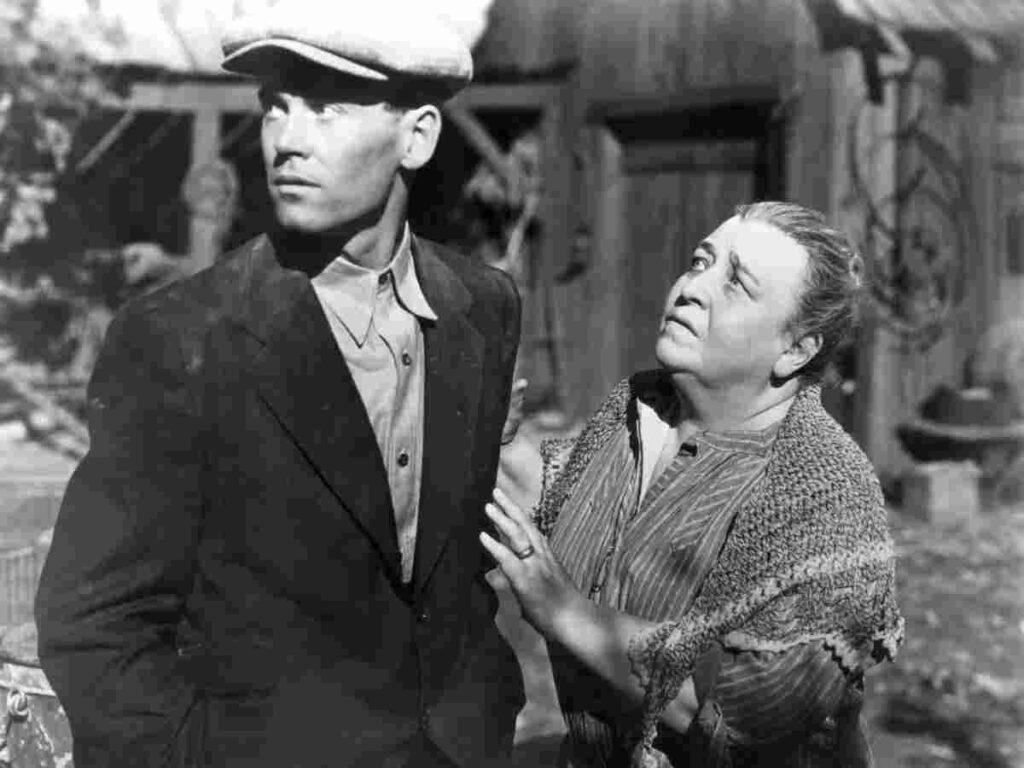When discussing iconic friendships in the realm of cinema, illustrious pairs like Top Gun‘s Goose and Maverick, Jai and Veeru in Sholay, or Sam and Frodo in The Lord of the Rings immediately come to mind. These dynamic duos have left an indelible mark on the silver screen, eliciting laughter, and tears from audiences. However, in the context of camaraderie, John Ford‘s 1940 American drama, The Grapes of Wrath, adapted from John Steinbeck’s 1939 Pulitzer Prize-winning novel of the same name, stands apart from these examples. Unlike the aforementioned films, The Grapes of Wrath does not center around a prominent double-act. Instead, it intricately weaves a philosophy of friendship and a sense of community into its narrative fabric.
At the heart of this film lies the understated friendship between Casy (John Carradine) and Tom Joad (Henry Fonda). While this relationship may not be the driving force of the plot, it serves as a conduit for exploring profound themes. Casy‘s ideologies catalyse Tom Joad‘s awakening from his dormant state, sparking his action and commitment. In a poignant conversation with Ma Joad before embarking on a new journey, Tom recalls Casy‘s beliefs, his life, and his ultimate sacrifice. These memories forge a connection to a broader community of working-class individuals and the struggles they face. Tom articulates this sentiment with urgency: “About our people living like pigs and good, rich land lying fallow. Or maybe one guy with a million acres and 100,000 farmers starving.” (The Grapes of Wrath, 1940).
The power of remembrance shapes our identities and experiences. Within the film’s narrative, Tom Joad elevates Casy‘s legacy, infusing it with purpose. This act of remembering imbues Casy‘s character with symbolic significance, representative of the downtrodden masses he championed. Aristotle once posited that friends reflect one another’s virtues, facilitating personal growth. Casy‘s demise redirects Tom Joad‘s trajectory, guiding him toward advocacy for the marginalized. He echoes Casy‘s notion: “Well, maybe it’s like Casy says… a fella ain’t got a soul of his own, just a little piece of a big soul. The one big soul that belongs to everybody.” (The Grapes of Wrath, 1940).
Casy‘s life and death become a lodestar for Tom, an exemplar guiding him to recognize his interconnectedness with the wider world of the oppressed. Casy‘s words illuminate Tom’s realization that his essence is a tessera within a larger mosaic of humanity, and his purpose unfurls as he aligns himself with this broader fraternity.
If The Grapes of Wrath is seen as a bildungsroman, then Tom Joad‘s character arc completes a profound circle. He evolves from a disenchanted and violence-prone youth into a defender of the rights of the downtrodden. His parting words resound with clarity, embodying his newfound calling: “I’ll be all around in the dark. I’ll be everywhere, wherever you can look. Wherever there’s a fight so hungry people can eat, I’ll be there. Wherever there is a cop beating up a guy, I’ll be there. I’ll be in the way guys yell when they’re mad. I’ll be in the way kids laugh when they’re hungry and they know supper’s ready. And when the people are eating the stuff they raise, and living in the houses they build, I’ll be there too.” (The Grapes of Wrath, 1940).
This poignant declaration, coupled with Henry Fonda’s nuanced portrayal of Tom Joad, epitomizes cinematic greatness. The director strategically employs shallow focus to isolate Tom Joad, compelling our focus toward the scene’s essence. Fonda’s penetrating gaze pierces through the screen, erasing the fourth wall, uniting the actor and audience in the plight of the oppressed. Tom Joad transcends his physical confines in his quest for ubiquity. He evolves into a vessel of universal brotherhood, embodying a higher essence, a deity in his own right. The spirit of unity fuses reality and imagination, uniting the audience in the realization of Casy‘s vision for a liberated, socially uplifted working-class community.
Banned, burned, and criticized for its portrayal of the struggles faced by the Okies, Steinbeck’s The Grapes of Wrath remains a masterpiece. It offers a panoramic perspective of one of the world’s most dire financial crises — the Great Depression. This narrative has gained renewed relevance during subsequent economic downturns, such as the 2008 financial crisis and the Covid-19 pandemic. These events left countless individuals in precarious positions, disproportionately impacting those already grappling with economic hardships. The plight of jobless migrants during the Covid-19 lockdown mirrors the challenges faced by the Joad family and their peers, symbolizing the ongoing tragedies of economic turmoil.
One might question how a cinematic narrative, a portrayal of reality, can illuminate the struggles of the marginalized in times of economic crisis. Works of literature and film, as creative narratives, offer alternate histories that foster empathy and understanding. Engaging with these narratives enables us to empathize with the vulnerable, fostering discussions that are crucial within our socio-culturally unequal milieu.
John Ford’s cinematic adaptation of Steinbeck’s work, while a diluted rendition of the original text, preserves its core spirit. The film subtly modifies controversial elements and tones down its political content to align with Hollywood conventions. While experimental mise-en-scène and expressionistic stylization are employed, the film remains faithful to the overarching narrative. Steinbeck’s essence endures, and the message of brotherhood finds subtle yet profound expression in the adaptation. Notably, the film’s nominations and awards underscore its impact.
Opening with Tom Joad‘s release from prison, the film traces his journey home, where he crosses paths with Casy and reunites with his family. Through the character of Muley, the collective trauma of eviction unfolds, uniting disparate families in a shared struggle against the forces of industrial capitalism. Ford employs deep focus and chiaroscuro contrasts to underscore the divide between the haves and have-nots, symbolized through their possessions and attire. These visual cues amplify the stark dichotomy between exploitative profiteers and the resilient, compassionate community of the dispossessed.
In a poignant climax, Ma Joad emerges as a beacon of hope and resilience. Despite adversity, her unwavering spirit encapsulates the ethos of the working-class community. Her resolute words resonate as a defiant manifesto: “We are the people that live. They can’t wipe us out; they can’t lick us. We’ll go on forever, Pa, because we’re the people” (The Grapes of Wrath, 1940). This final assertion reaffirms fraternity, inspiring hope and underscoring the enduring vitality of the marginalized. Ma Joad‘s proclamation mirrors Tennyson’s Ulysses, championing the indomitable human spirit.
In conclusion, The Grapes of Wrath transcends melodrama through its nuanced exploration of friendship, community, and resilience. Amidst dire economic circumstances, its characters embody universal principles of unity, empathy, and determination. As a creative narrative, the film serves as a powerful conduit for understanding the struggles of the marginalized and instilling hope for a more just future. Its impact resonates, prompting critical conversations within the framework of our socio-cultural landscape. Through its artistic lens, The Grapes of Wrath continues to illuminate, inspire, and provoke contemplation, making it an enduring testament to the power of cinematic storytelling




